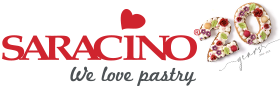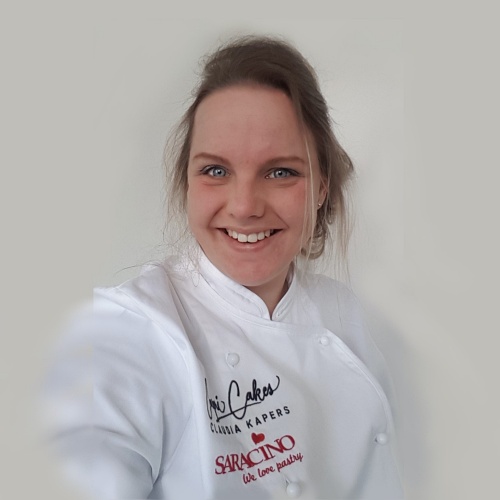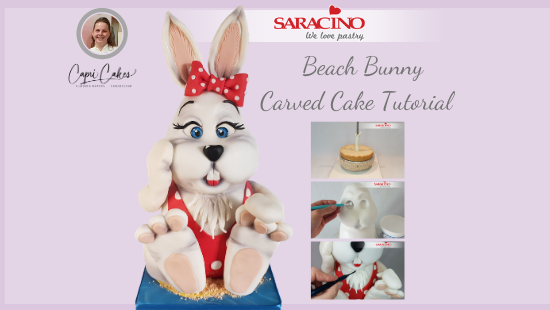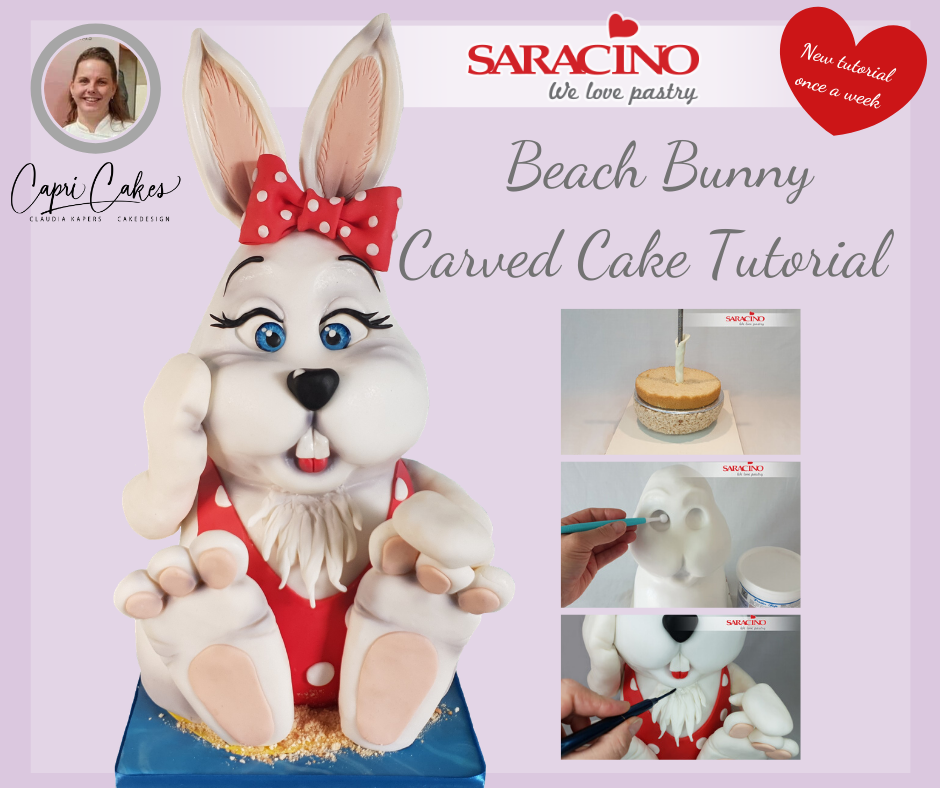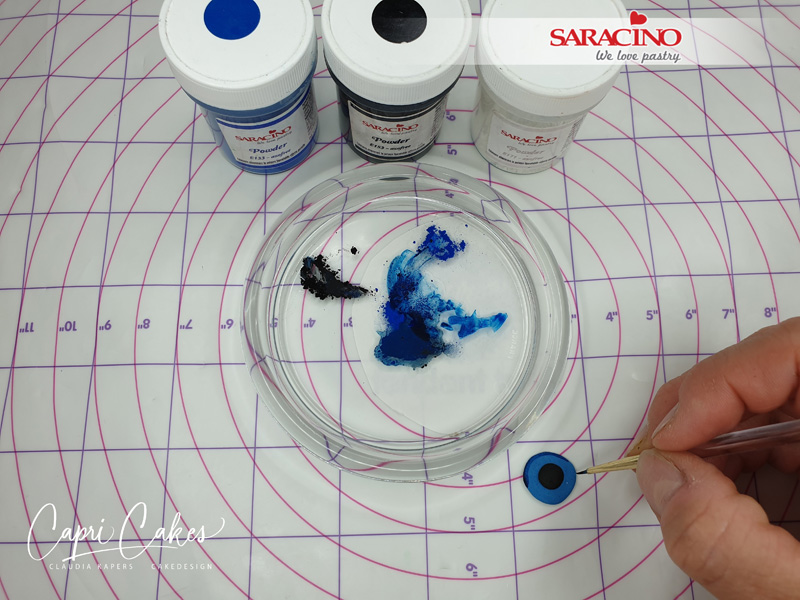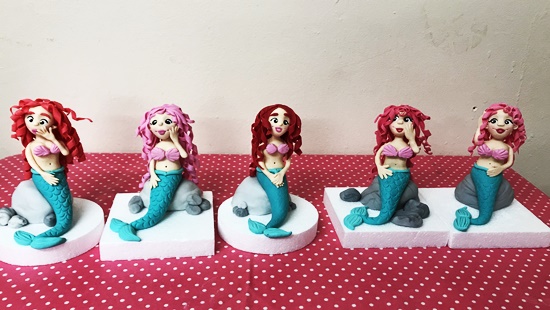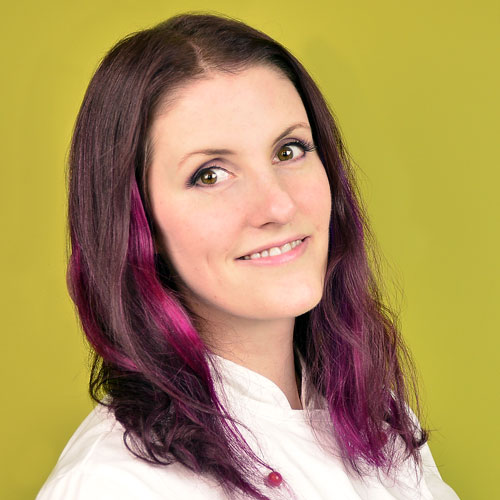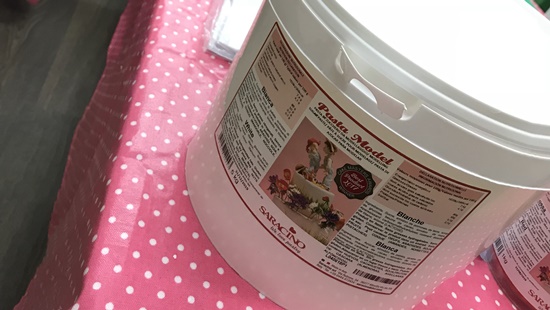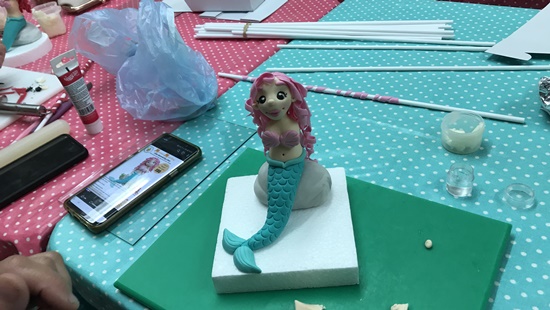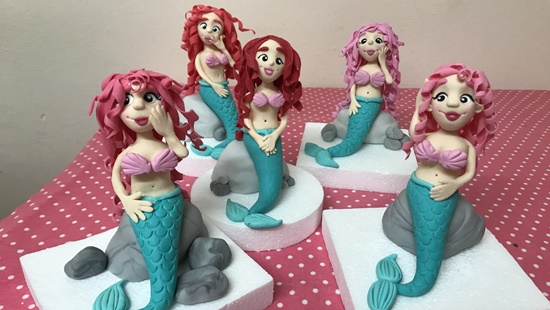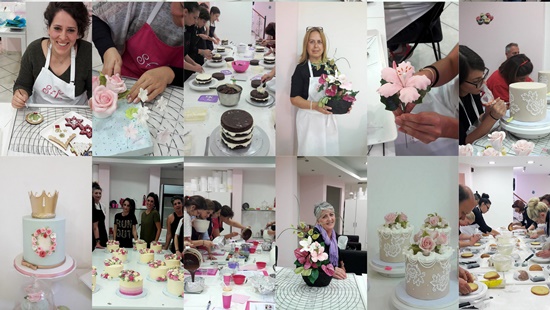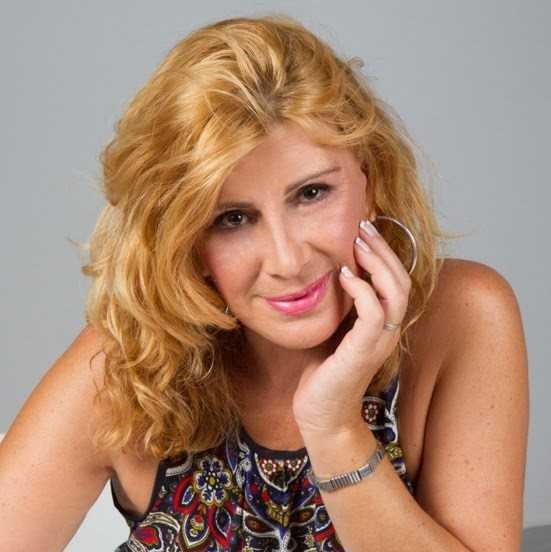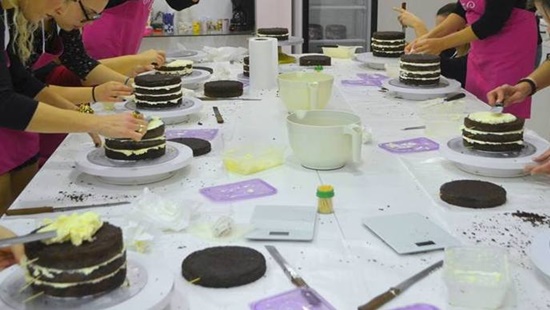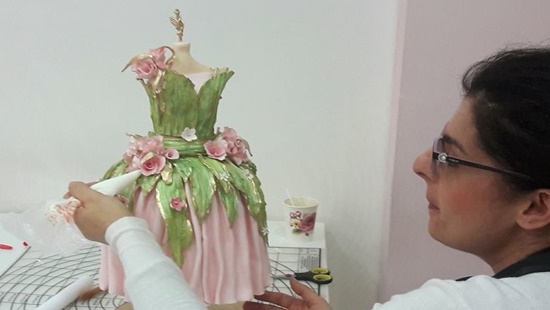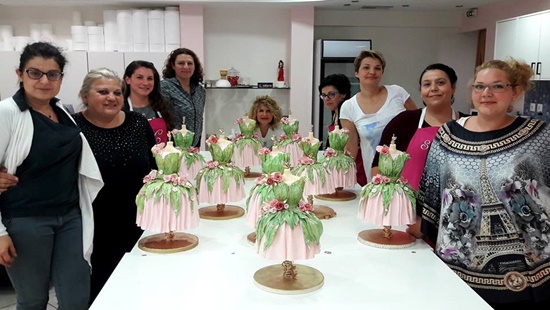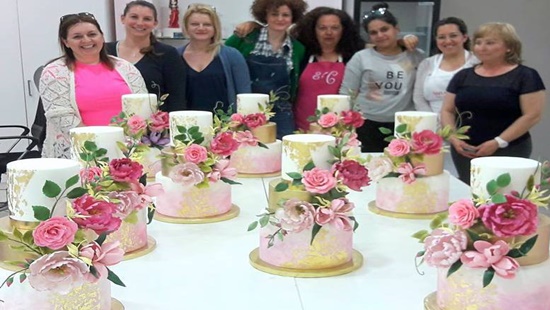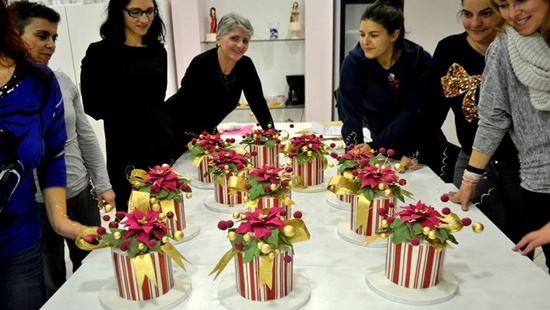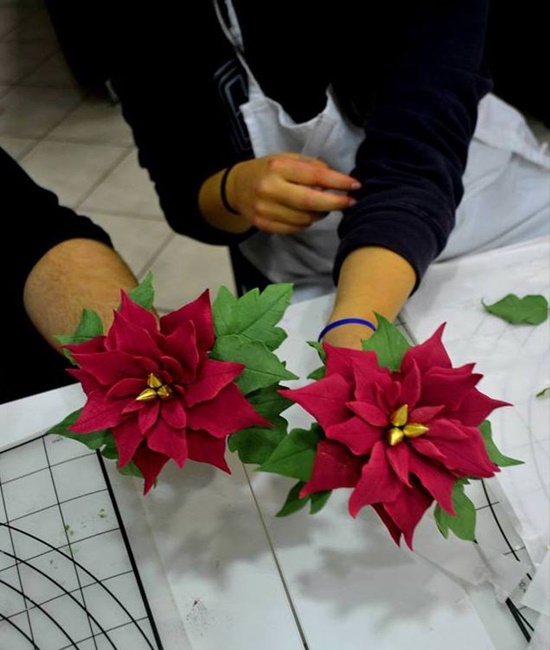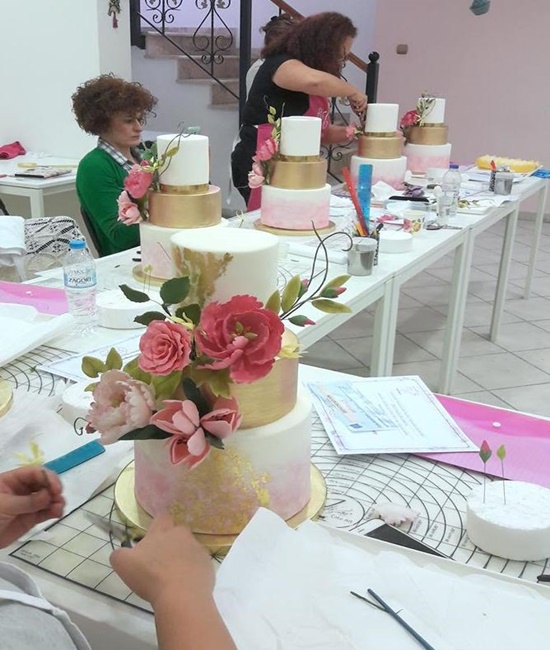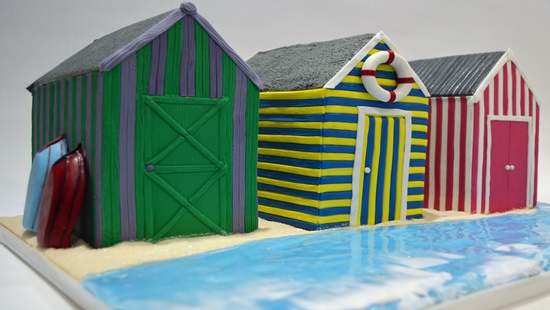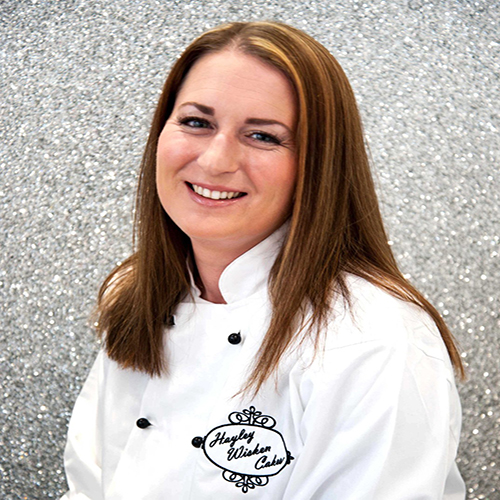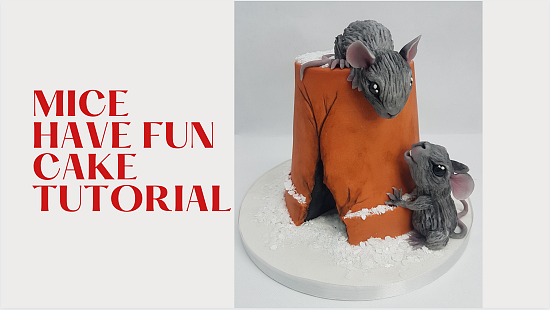
MICE HAVE FUN CAKE TUTORIAL

You will need:
- Ingredients:
- Saracino Pasta Top white and black
- Saracino Pasta Model white and black
- Saracino white modelling chocolate
- Gel colours orange, light skin and black
- Powder colours black, pink and brown
- Cake gel
- Rejuvenator spirit alcohol
- Boiled cooled water
- Wafer paper 0.6 or 0.27
- Pump powder silver glitter
- Equipment:
- Conical dummy or cake diameter 15cm by 10cm
- Drum 25 cm (10 inch)
- Rolling pin
- Sharp knife
- Dresden tool
- Ruler
- Modelling tools
- Cake smoother
- Brushes
- Wood cocktail sticks
- Food processor
- Ribbon

Step 1
Use a conical dummy (or cake) with a lower diameter of 15cm and 10cm at the top and a 25cm diameter drum. If you use a cake, trim so that it is a conical shape.

Step 2
Form a triangular cut out in your cake or dummy so it looks like it has a hole in it.
If you use a real cake cover the cake with ganache.

Step 3
Prepare a small piece of black Pasta Top until smooth and pliable. Roll to your preferred thickness. Add a little cake gel inside the hole and press in the black fondant to line the hole. Use a Dresden tool to press the fondant to the sides and to add shape.

Step 4
Remove the excess paste with a sharp knife.

Step 5
Using 350g of white Pasta Top make a dark orange colour by mixing the orange and light skin tone gel colours. Add as much of the light skin colour as you want to achieve the desired colour of the flower pot. You can also use a different base colour for your flower pot. Knead the paste until smooth and pliable. Roll to your preferred thickness (Saracino Pasta Top can be rolled very thinly and is very stretchy. Perfect for covering large or unusual shaped cakes).

Step 6
Cover your real cake with ganache or the dummy with boiled, cool water or cake gel to help the fondant stick. Place the dummy (or cake) on the cake board.

Step 7
Place the fondant gently over your dummy (or cake). Smooth the top and edges with your hand. Sharp edges are not necessary as it is a rustic flower pot. Gently pull out the folds and smooth down with your hand pressing the paste to the dummy (or cake) until all folds are gone. Trim off the excess fondant with a sharp knife. Keep the cuttings in a sealed bag for later use.

Step 8
Carefully cut out the paste that is covering the hole at the bottom of the dummy with a sharp knife. It can be cut a little roughly.

Step 9
Draw lines with a Dresden tool that start from the edges of the hole. Make the lines random and vary the depth of the lines.

Step 10
To cover the cake drum use a small amount of white Pasta Top and knead it well. Roll out to a thickness of 0.2mm. Cut 5cm wide strips (width is to suit the size of drum you used).
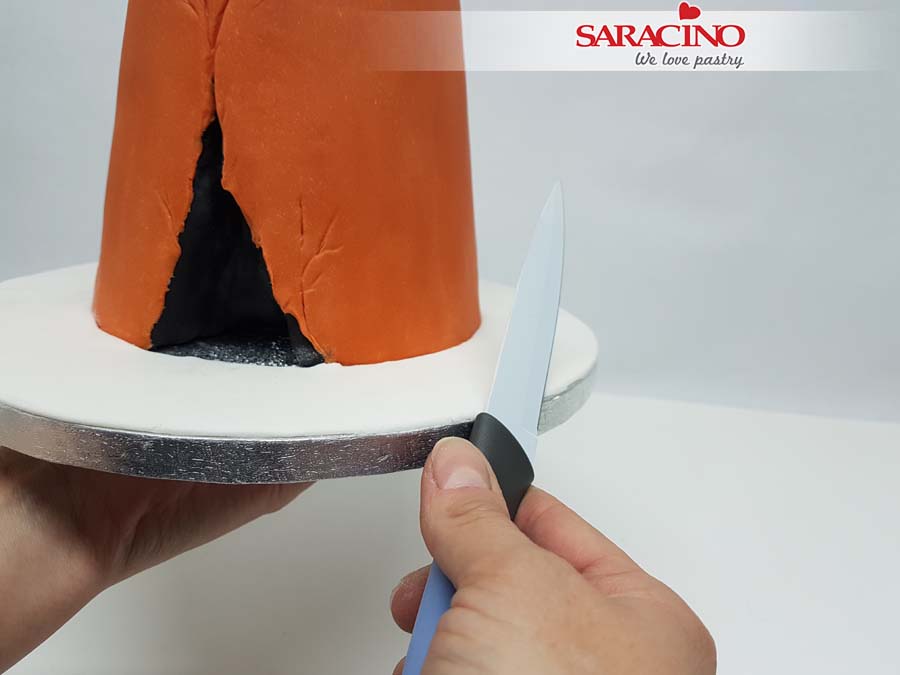
Step 11
Add a little cake gel to the drum. Cover the drum with the white Pasta Top strips. Start at the back and gently pull it around the cake placing it onto the drum. Due to the high elasticity the fondant does not tear. Cut away the excess paste.
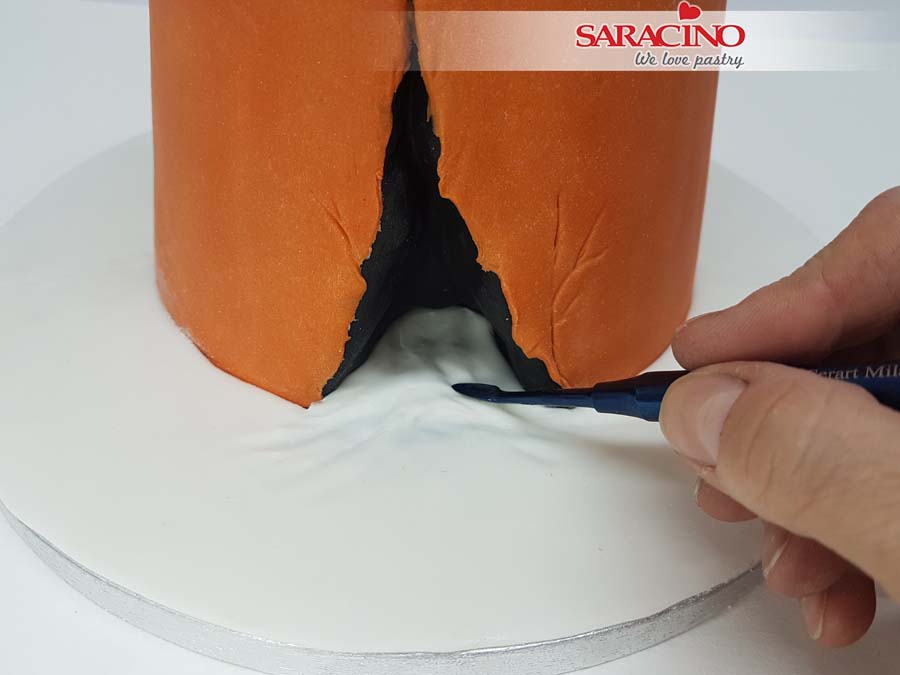
Step 12
Using a small amount of white Pasta Top cover the visible part of the drum in the hole of the cake. Add texture with the Dresden tool.
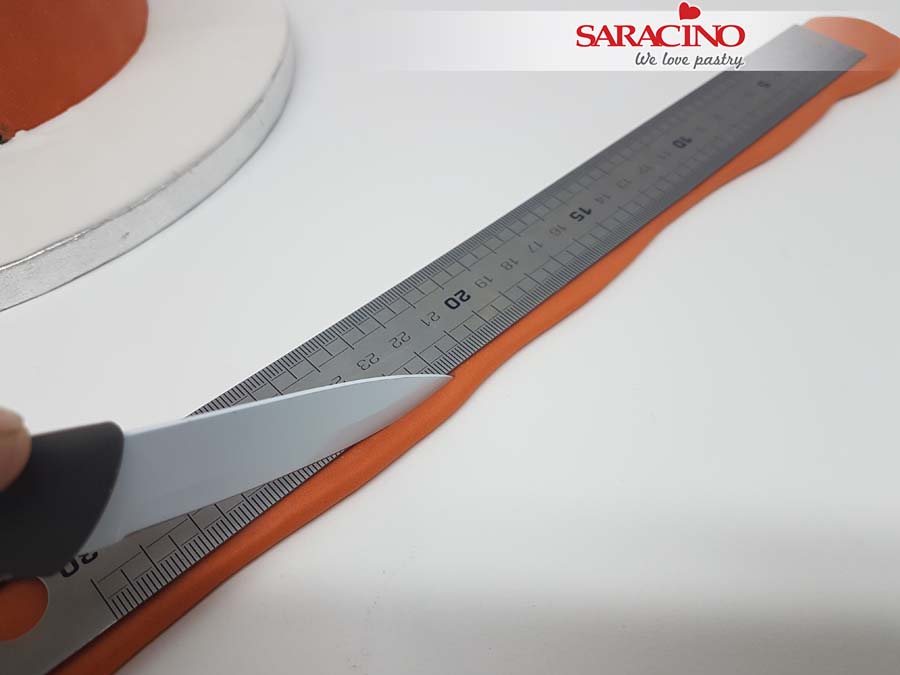
Step 13
For the thick rim of the plant pot use 170g of the dark orange Pasta Top and roll into a thick strip. Roll out the strip to 5mm thick. Don’t roll it out too thin! Cut out a strip of 3cm wide and approximately 50cm long.
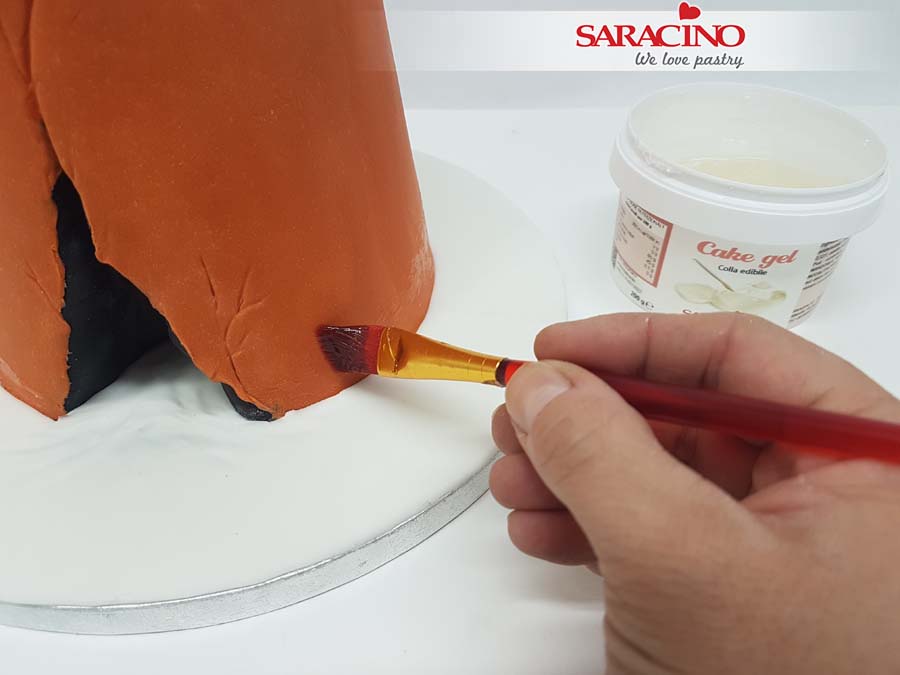
Step 14
Apply a little cake gel around the bottom of the cake.

Step 15
Fix the 3cm strip around the bottom of the cake and cut off the excess. This does not have to be super neat as we want it to have a ‘broken’ look.

Step 16
For the mouses body use 250g of white modelling chocolate. Knead until soft. Do not knead for too long as it may become too soft for modelling. Add a little black gel colour while kneading. Weigh 60g and roll to a tear drop shape.
Tip: If the modelling chocolate has become too soft allow it to rest for a while to cool down.
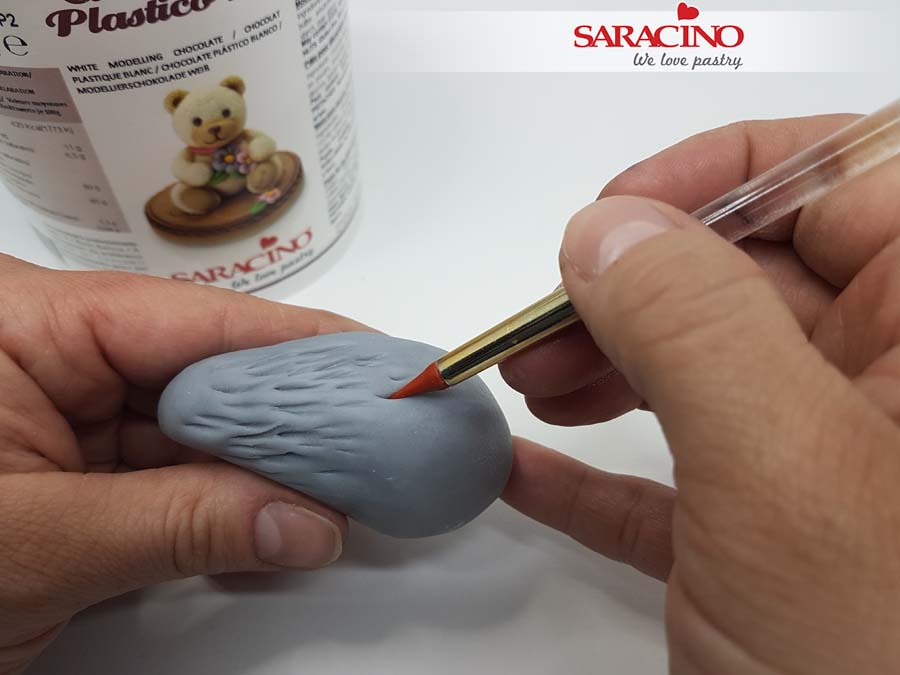
Step 17
Add fur texture with a modelling tool. Mark the paste in various directions to get a random effect. Make sure you work in one direction as this will give the hair structure look.
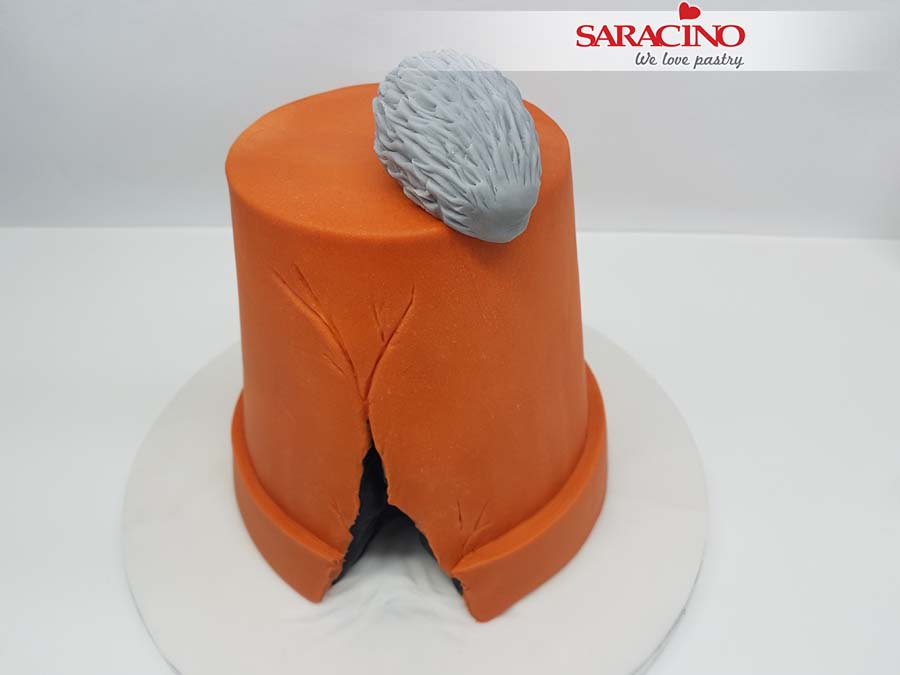
Step 18
Use a little cake gel to fix the body on top of the cake.
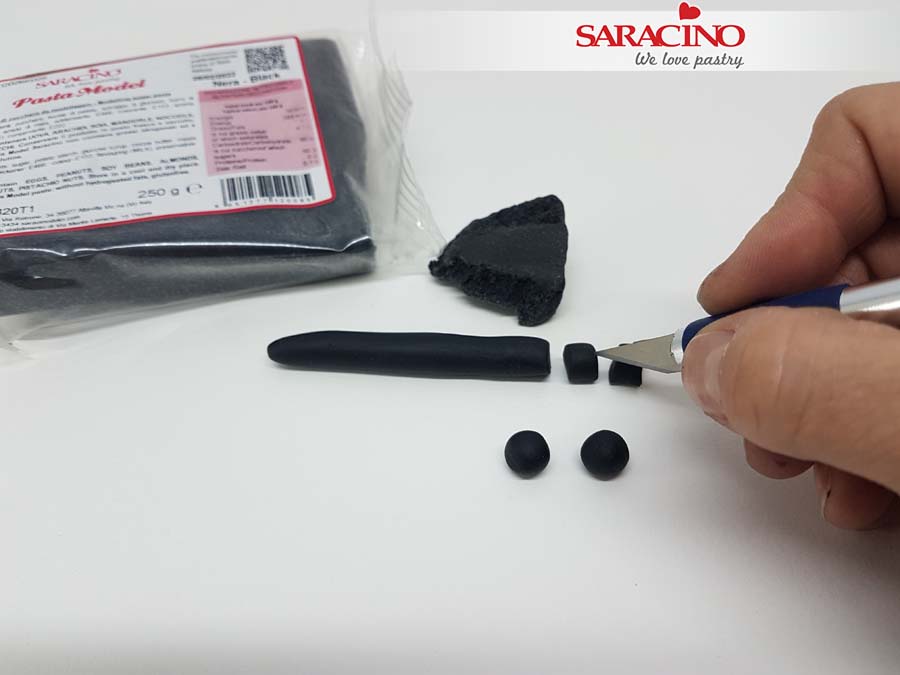
Step 19
Using 5g of black Pasta Model roll into a 5mm thick string. Cut 4 pieces with a weight of 0.5g and roll to a ball shape for the eyes. Allow them to harden.

Step 20
For the head use 40g of grey modelling chocolate and roll to a tear drop shape. Do not hold the modelling chocolate in your hands for too long as it may become too warm and it will be less easy to work with.
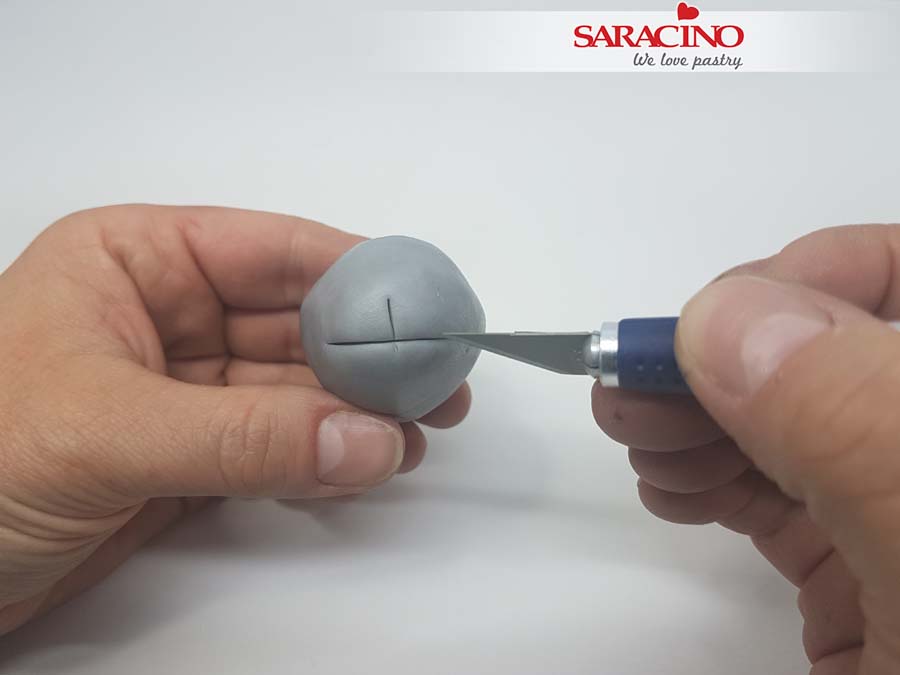
Step 21
Make a horizontal cut on the thin end of the teardrop. This will be the mouse’s mouth. Make a 0.5cm vertical cut above this for the nose area.
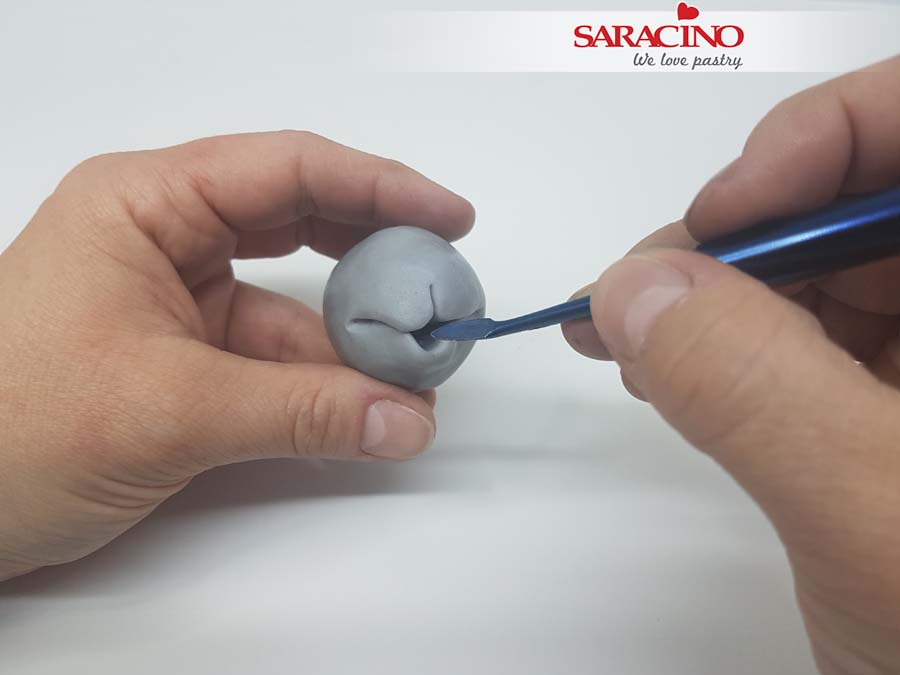
Step 22
Model the mouth with the Dresden tool. Press the chocolate down in the middle and press out to the sides. Press the bottom of the mouth in a little bit. Shape the front of the muzzle.
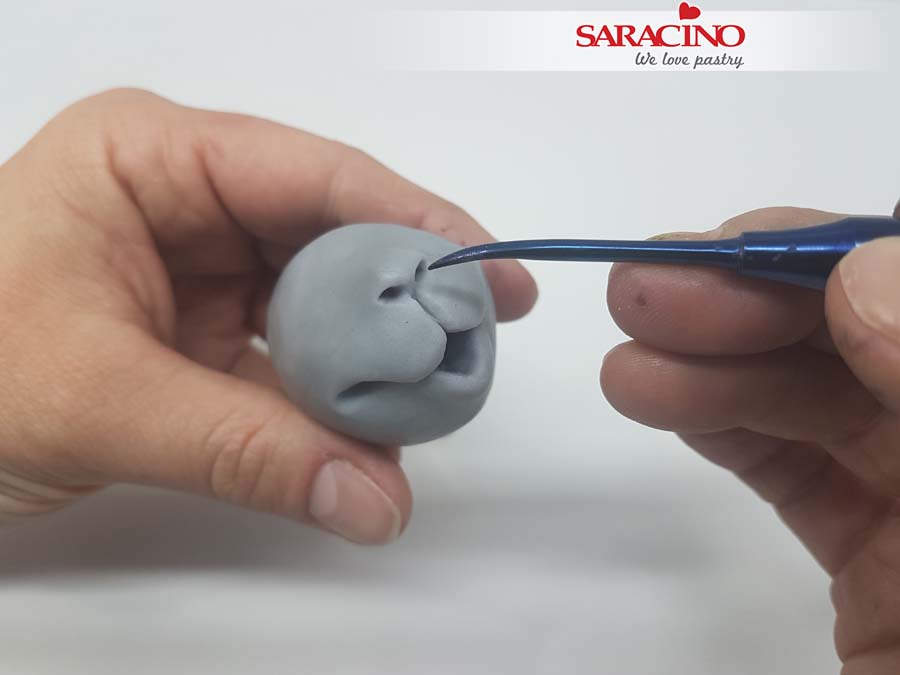
Step 23
Shape the nose with the narrow end of the Dresden tool. Insert the tool either side of the vertical cut and gently pull up slightly. This gives volume to the nose.
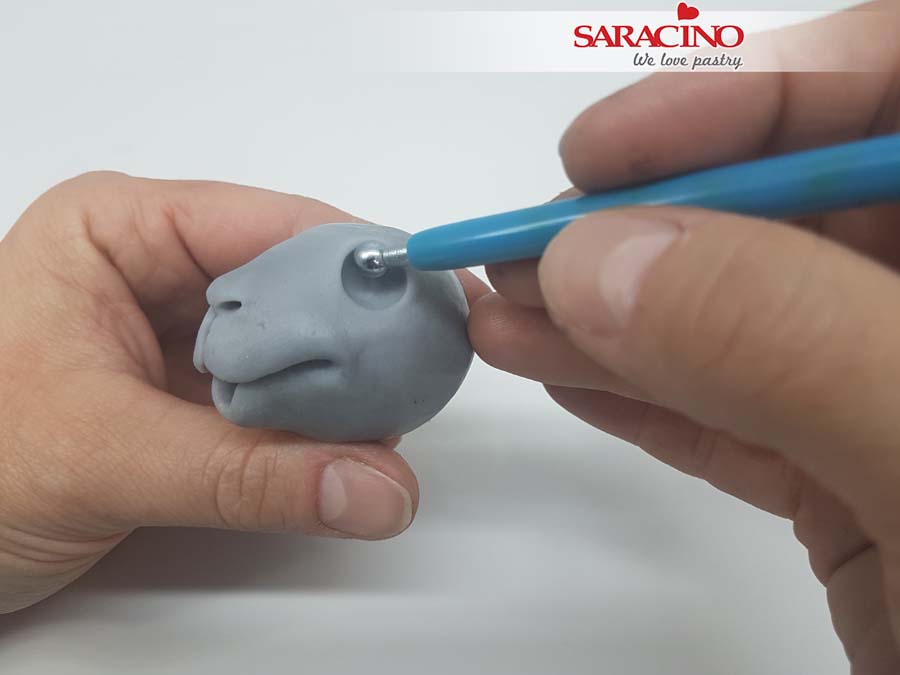
Step 24
Form a socket of 5mm diameter for the eyes on either side of the head with the ball tool.
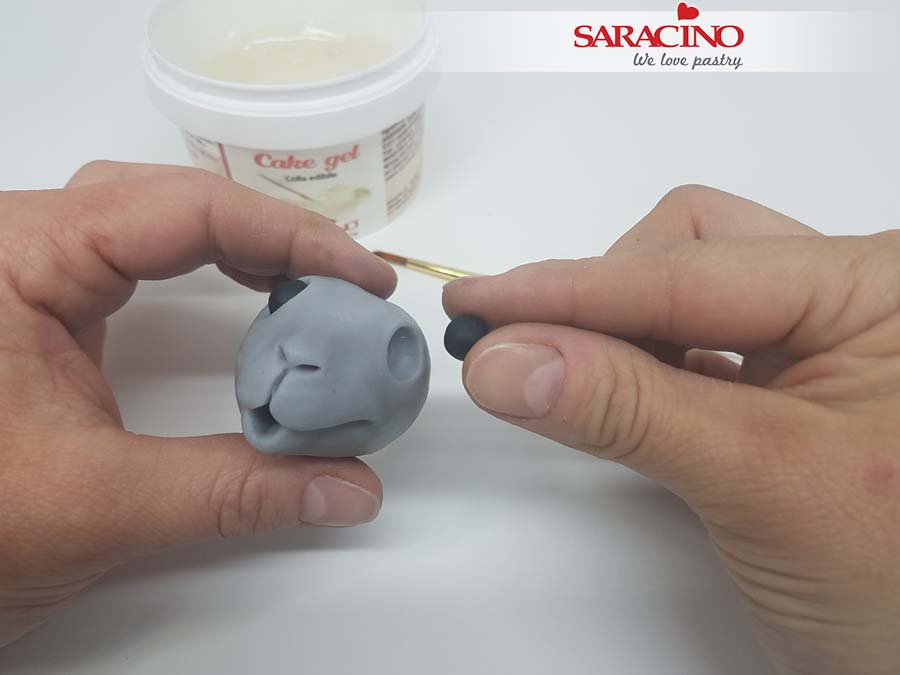
Step 25
Use a little cake gel to fix the eyes into each socket.
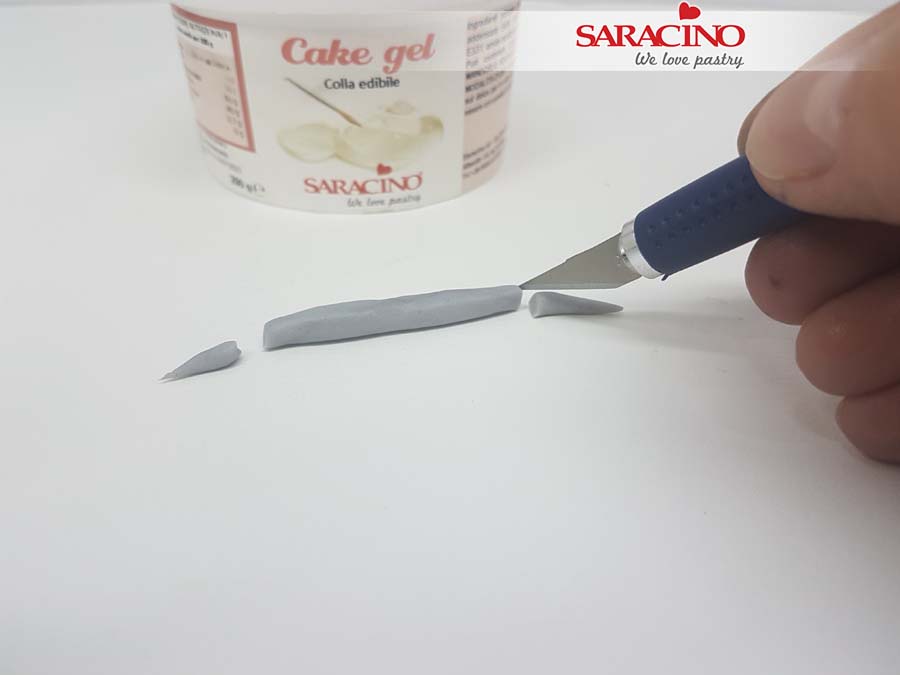
Step 26
Roll a thin strip with pointed ends out of grey modelling chocolate. Cut a length of 1cm from each end for the eyelids.
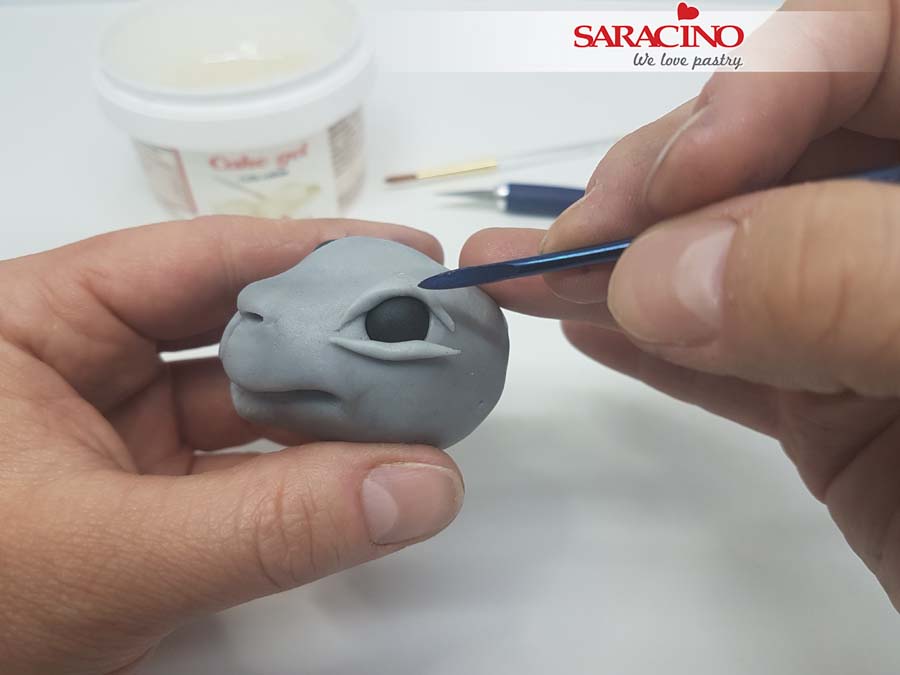
Step 27
Make sure that both ends are pointed. Fix the eyelids below and above each eye.
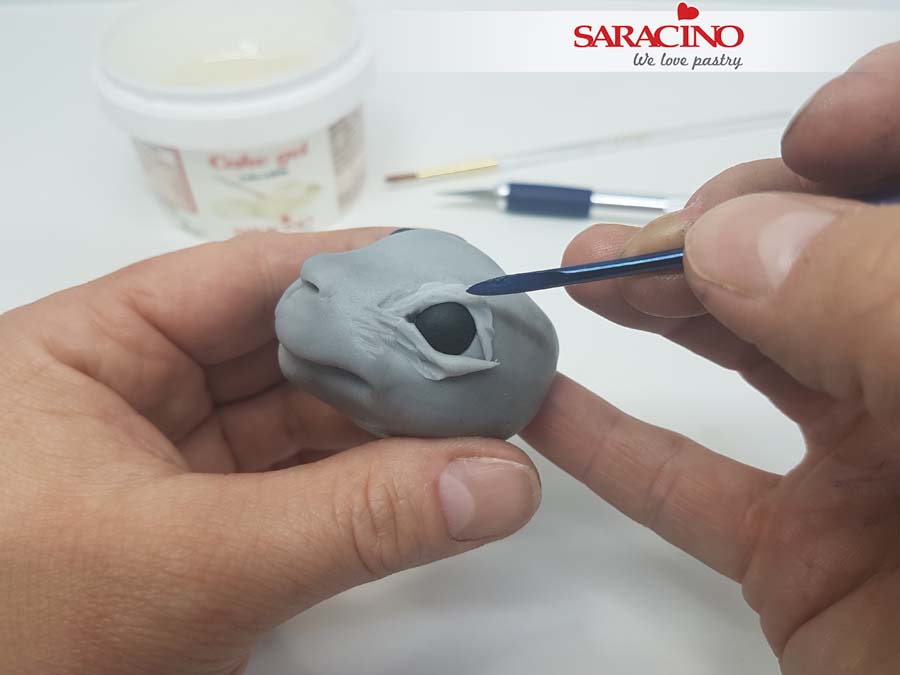
Step 28
Using your Dresden tool blend and shape the face and eyelids.
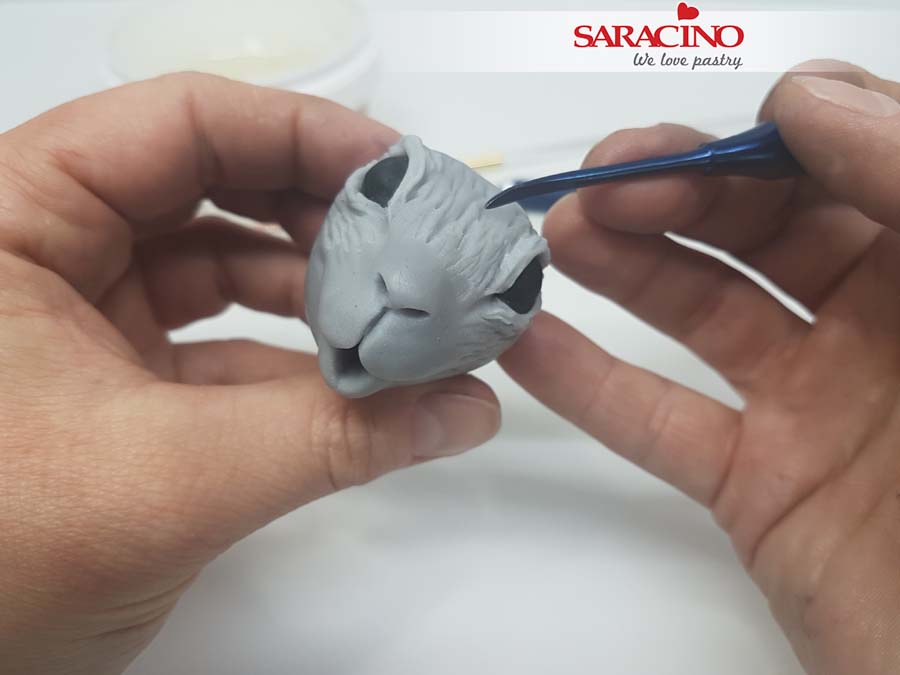
Step 29
Add the fur texture to the head. Make sure to work back from the front of the muzzle. Again, do not hold for too long otherwise it may become too warm and deform. If it is too soft to work with place aside to allow to cool.
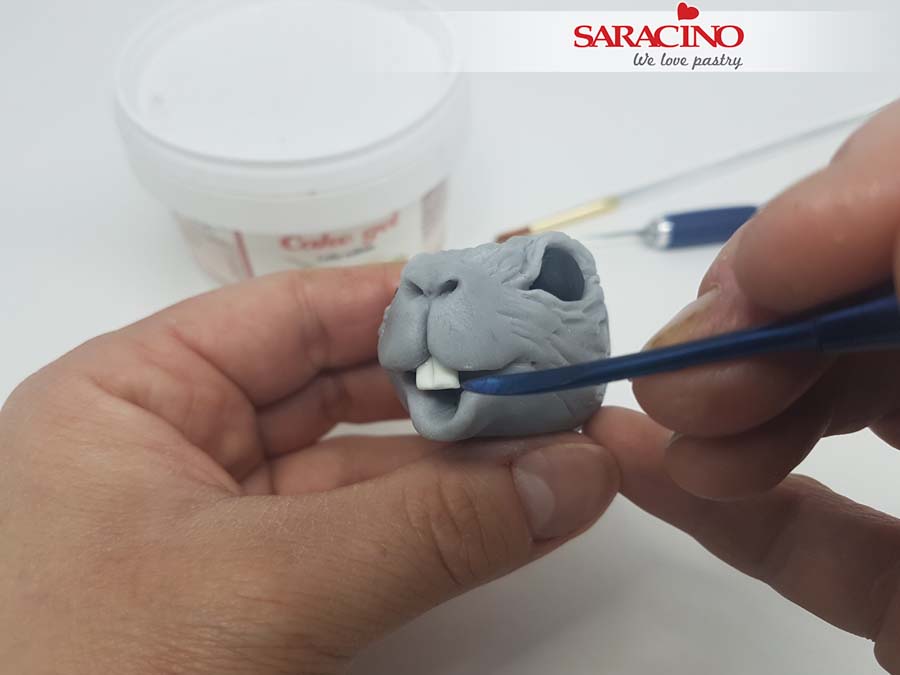
Step 30
For the teeth cut a 3 x 3mm square of white Pasta Model. Cut off the corners and press a line in the middle with your knife. Fix the teeth using a little cake gel.
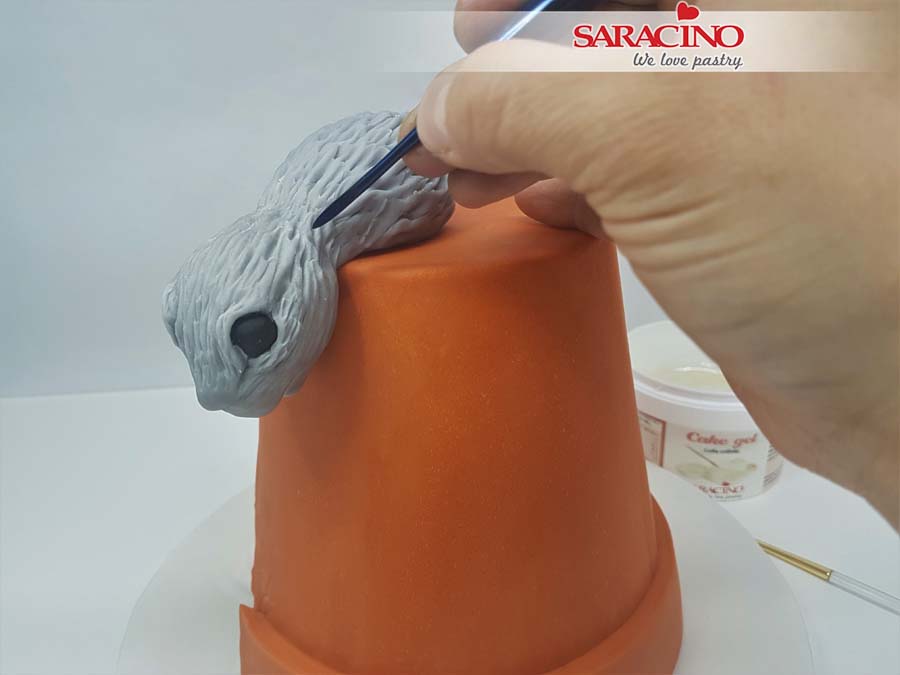
Step 31
Attach the head to the body looking down. To fix you can use cake gel with a cocktail stick.
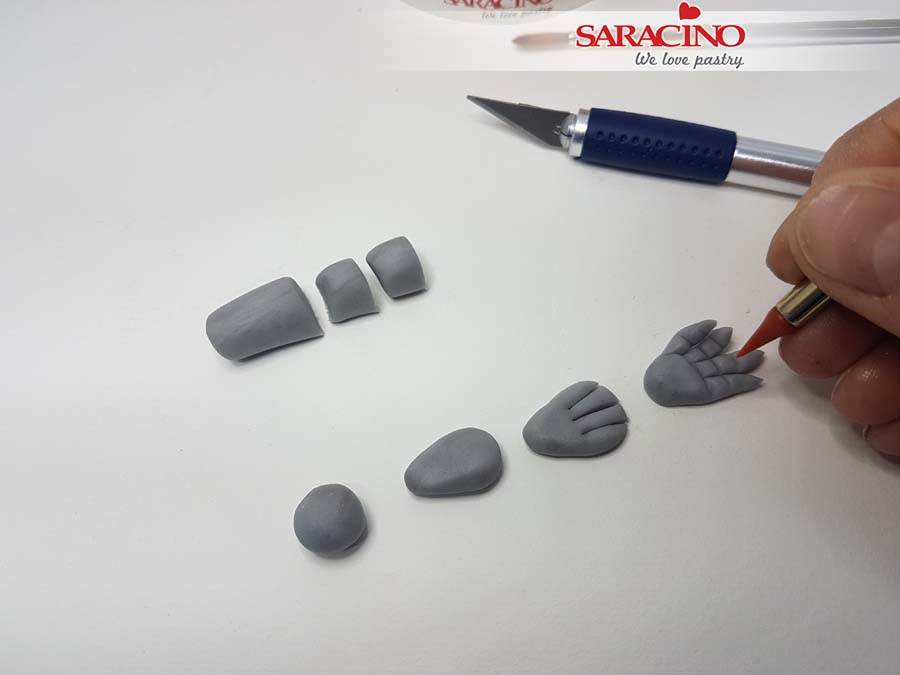
Step 32
For the feet take 4g of grey modelling chocolate and divide into 4 equal pieces. Roll one piece into a ball and press flat with your finger. Cut 4 notches on the front of the flat circle with a sharp knife. Shape the toes. Press two horizontal lines into the toes with the back of your knife. This allows you to shape them more naturally. Repeat these steps until you have four feet.
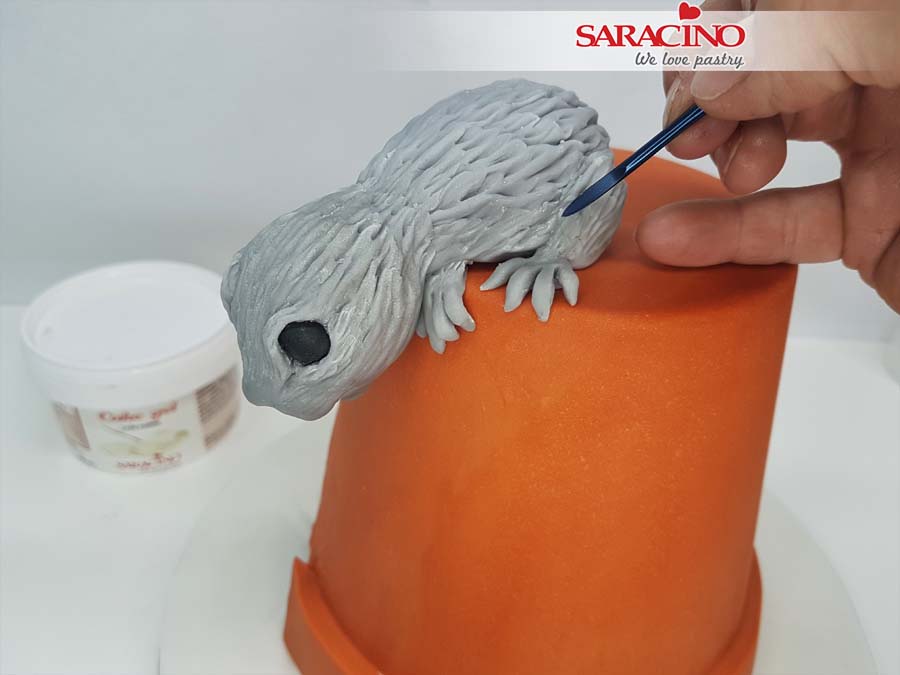
Step 33
Fix a foot to the body either side of the head. Blend to the body with a modelling tool. For the left back leg use 2.5g of grey modelling chocolate and roll to a long oval shape. Fix to the left back of the body. Fix the paw to the leg and add fur texture. Make sure that the leg is well blended into the body and foot. Repeat for the right back leg.
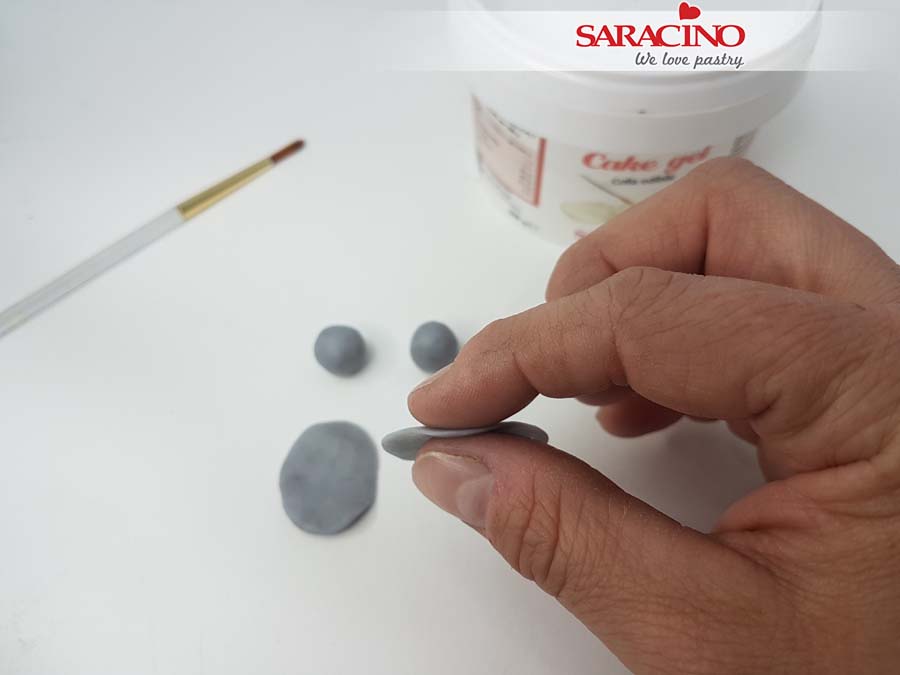
Step 34
For the ears use 3g of grey modelling chocolate. Divide into two equal pieces and flatten with your finger into a circle with a diameter of 2cm. The circles should be a little thicker in the centre and thin around the outside.
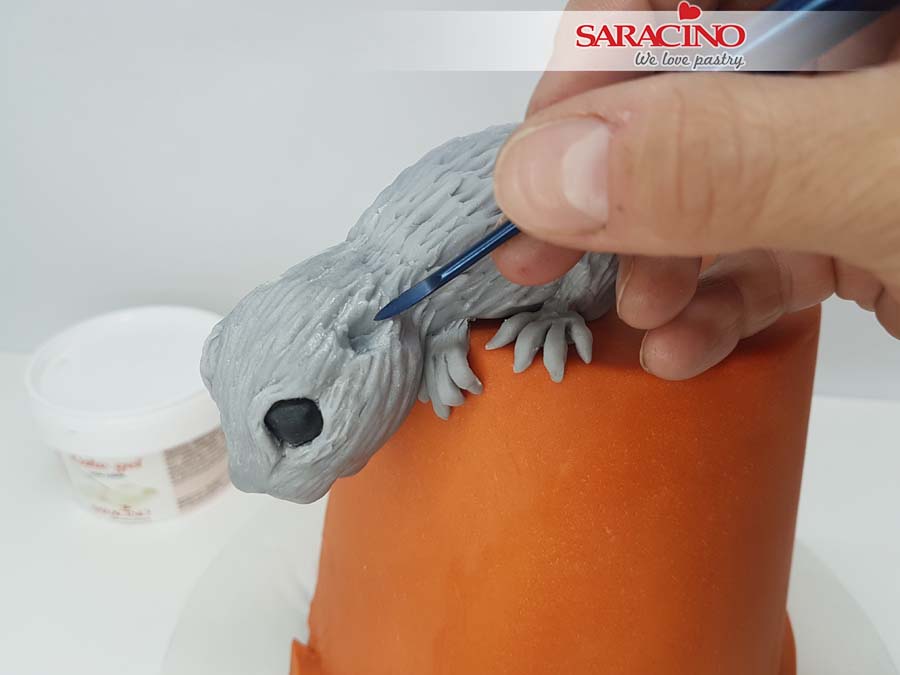
Step 35
Using your Dresden tool make a small hole in the head of the mouse.

Step 36
Fix the ear into the hole. Press with the Dresden tool to blend the ear to the head.

Step 37
Fix the other ear.

Step 38
For the second mouse, repeat step 20 and place the body upright on the drum. Add a cocktail stick for fixing the head.
TIP: If you want the models to be fully edible you can use uncooked spaghetti or no skewer at all.
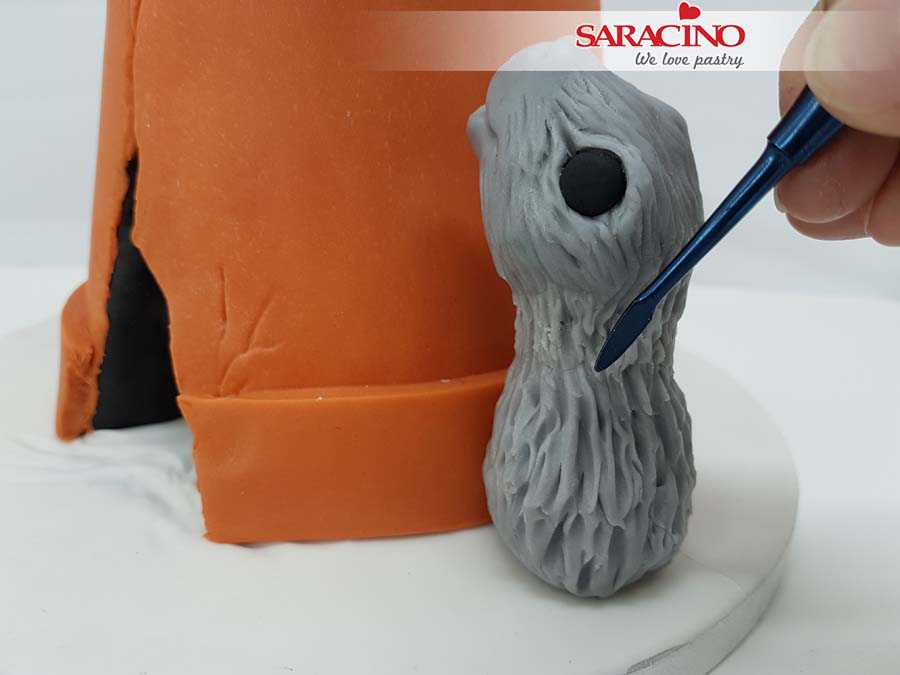
Step 39
Make a head following the steps from the first mouse. Attach the head looking upwards. You can add a little modelling chocolate to the neck for extra reinforcement and blend. Add the fur texture.
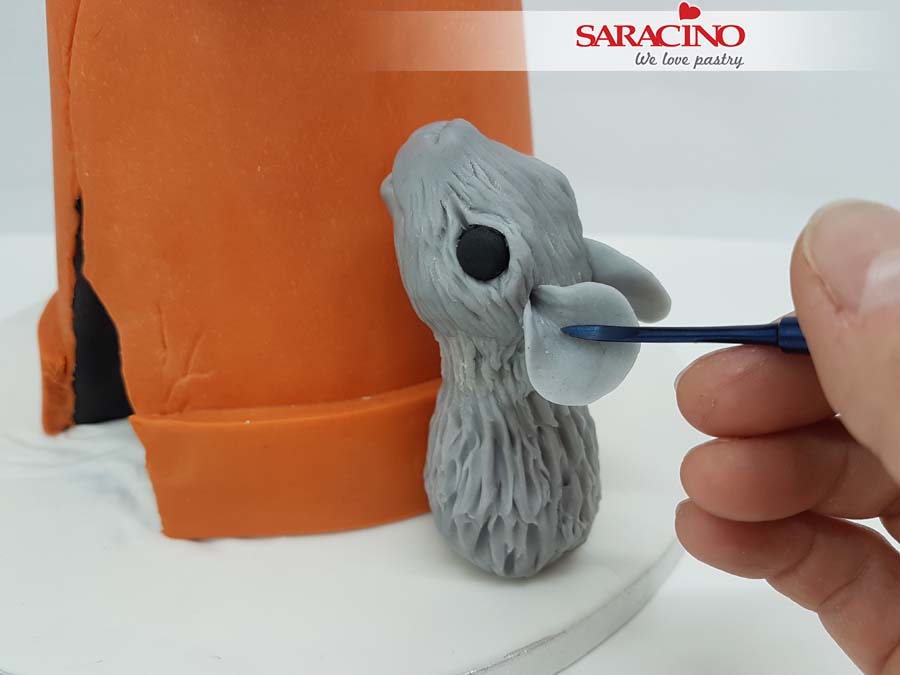
Step 40
Add ears as we did for the first mouse.
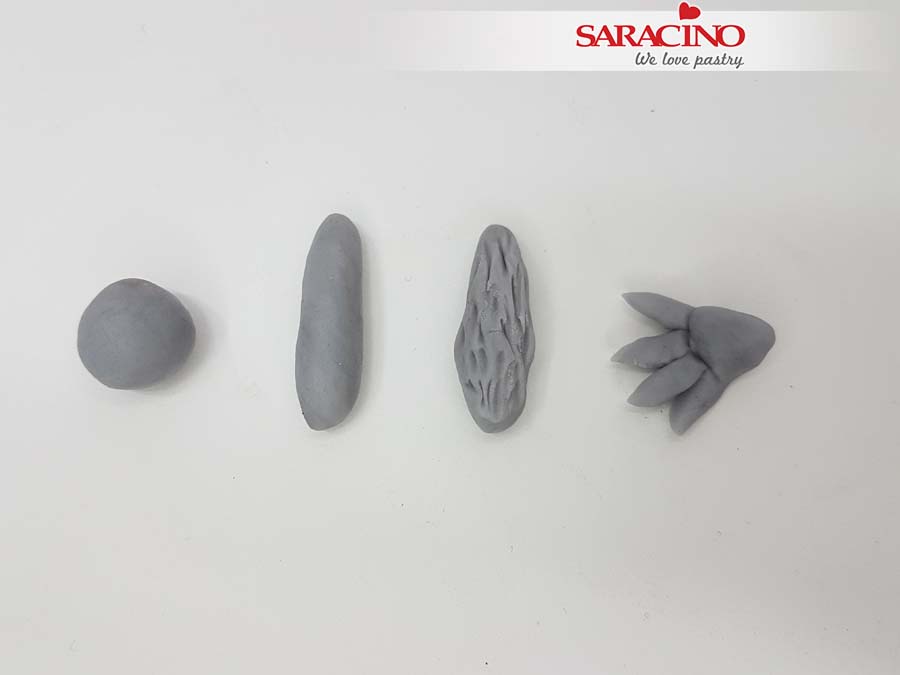
Step 41
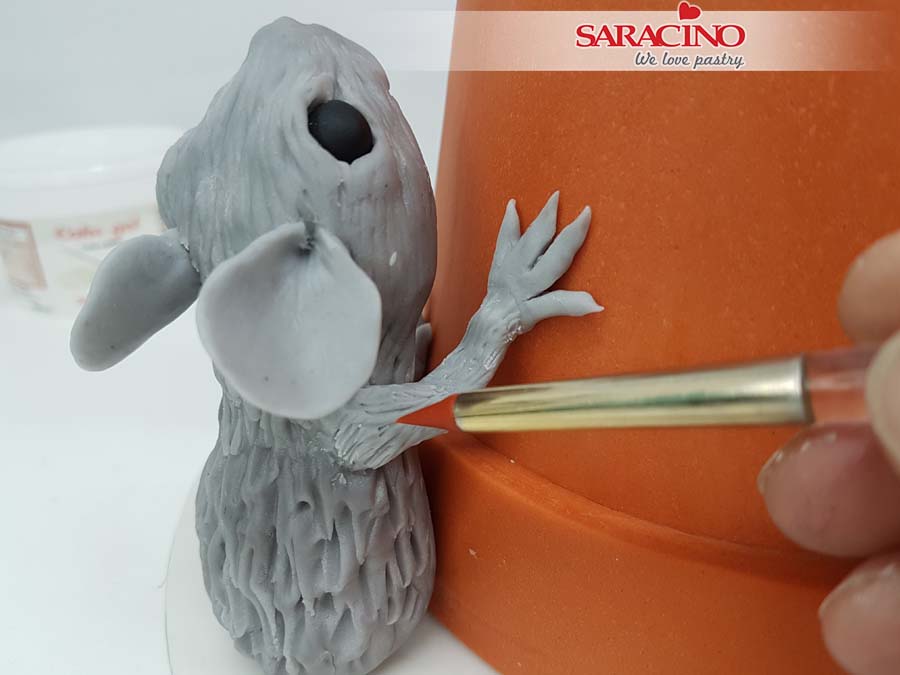
Step 42
Fix the foot to the leg. Fix the paw to the flower pot and fix the arm to the body of the mouse. Use a small amount of cake gel to fix. Repeat for the second front leg.

Step 43
For the back legs use 2.5g of grey modelling chocolate and shape to a long oval shape. Fix to the side of the body and fix a foot. Add fur texture and blend all joints. Repeat for the other back leg.
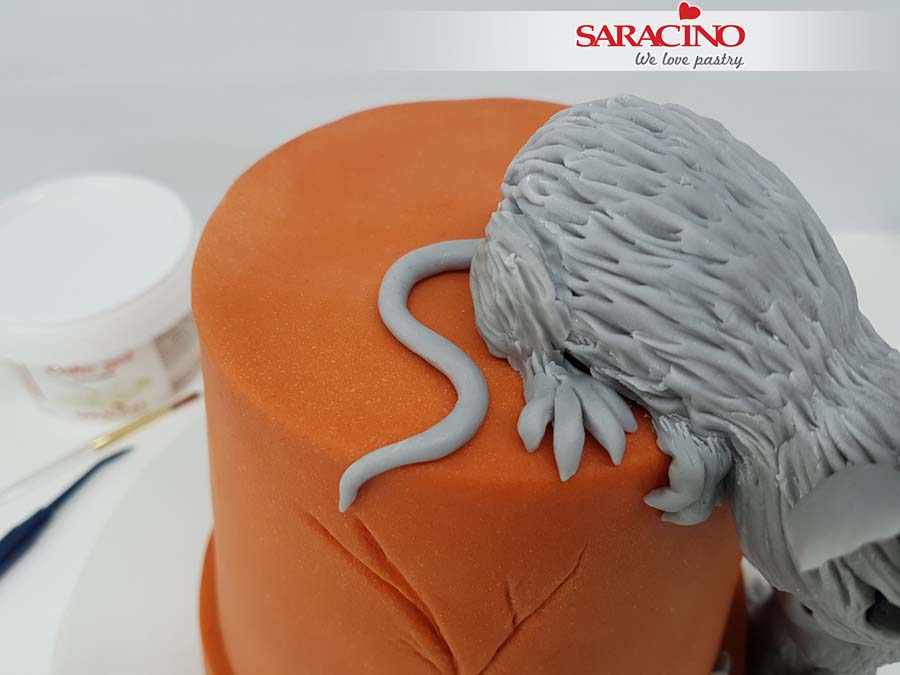
Step 44
For the tail roll 2g of grey modelling chocolate thinly to a length of 10cm. Give the tail an “S” shape and set aside to harden. Fix to the mouse.
TIP: You can also put the tail up in the air. As modelling chocolate is hard when cold, you can model the tail upright. Let your own creativity run free.
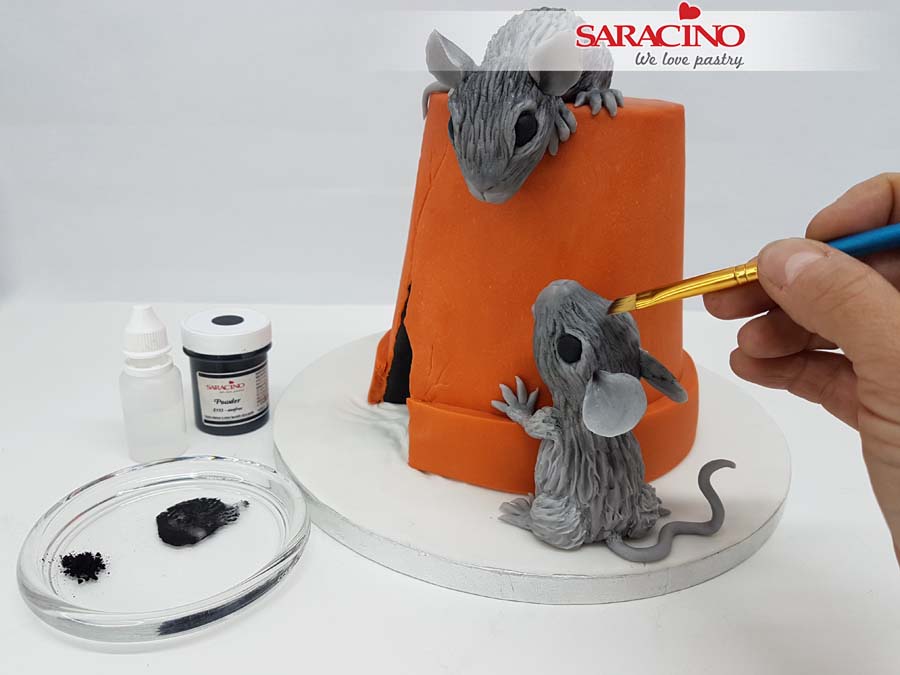
Step 45
Mix a small amount of black powder colour with clear alcohol to create a weak watered paint. Use a brush to paint the mouse fur. We want the paint to run into the grooves of the fur as this creates nice colour and shades.

Step 46
Using a soft brush and pink powder colour dust the toes, tail, ears and cheeks.
TIP: Cover the area around the part to be dusted with a tissue. This way you prevent other parts of your model being coloured incorrectly.
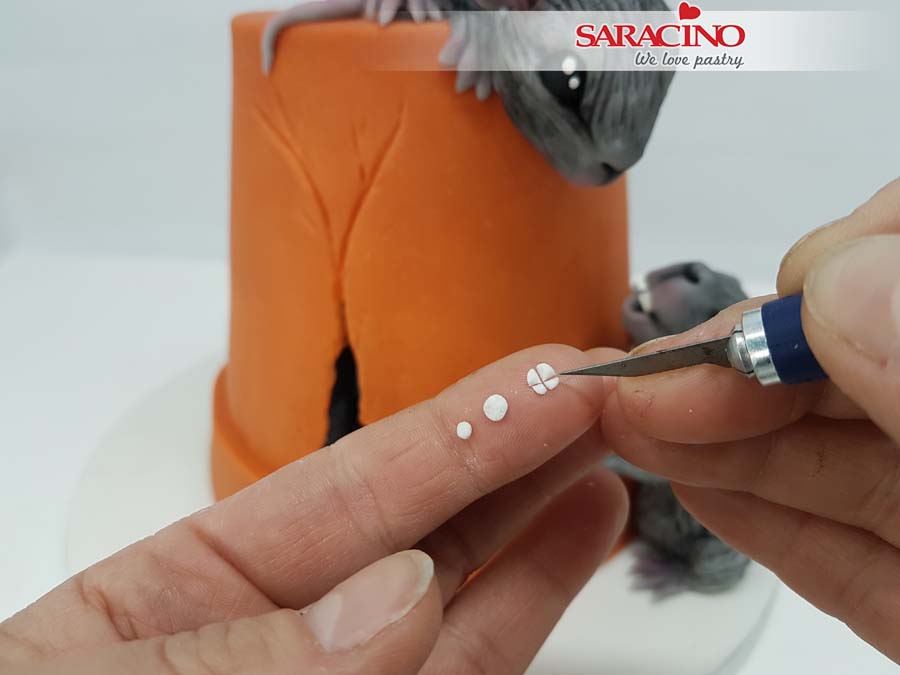
Step 47
For the eyes roll a small ball of white Pasta Model and press flat on your fingertip. Cut into four. Roll small balls and fix to the eyes.
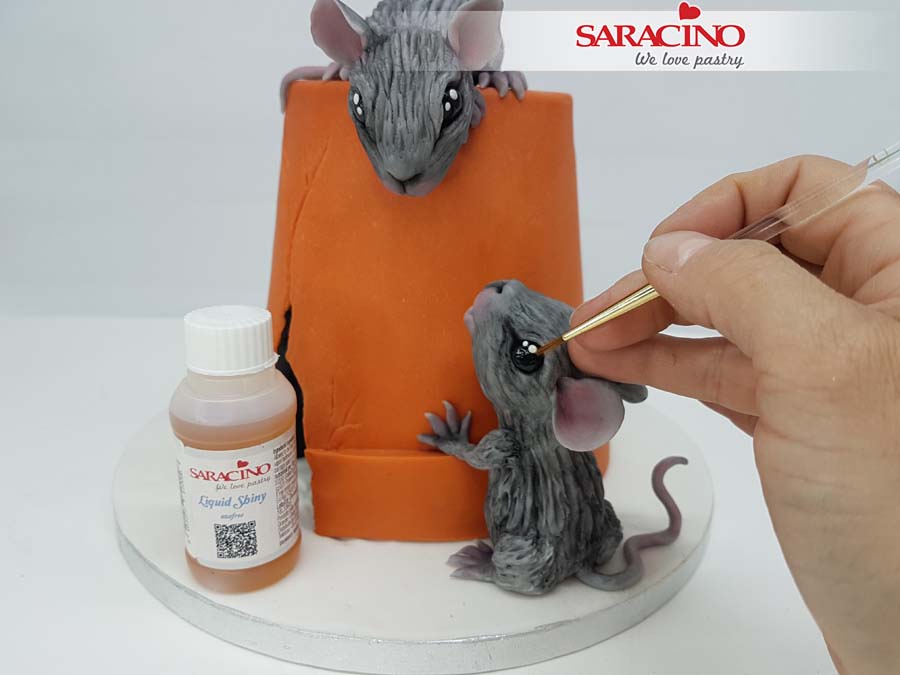
Step 48
Paint the eyes with Liquid Shiny.
TIP: Clean the brush with clear alcohol.
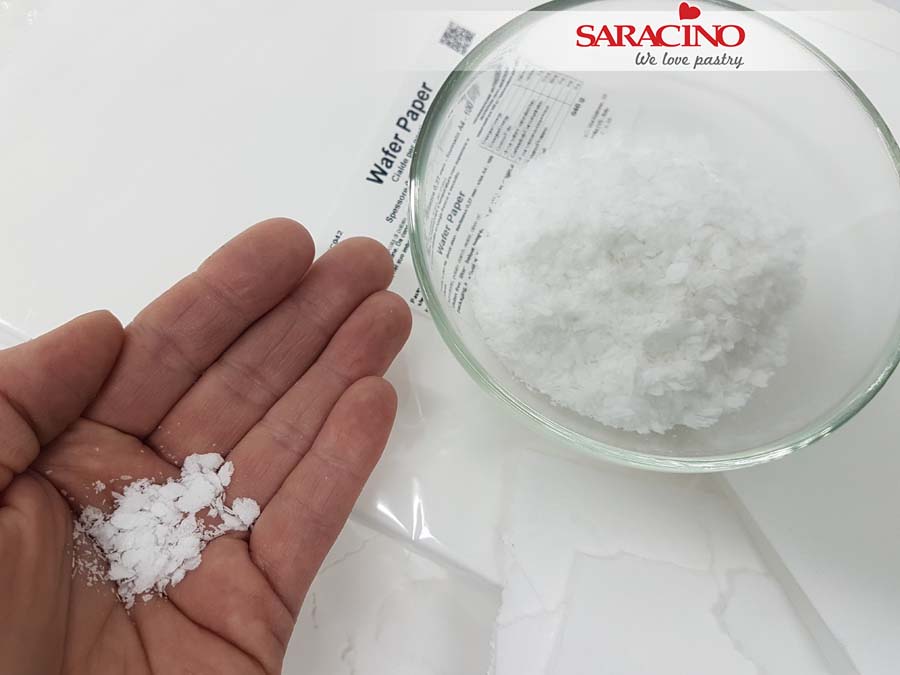
Step 49
Take one sheet of 0.60mm wafer paper (or two sheets of 0.27mm) and tear into small pieces. Place the pieces in a food processor or blender. Blend until it is in very small pieces.
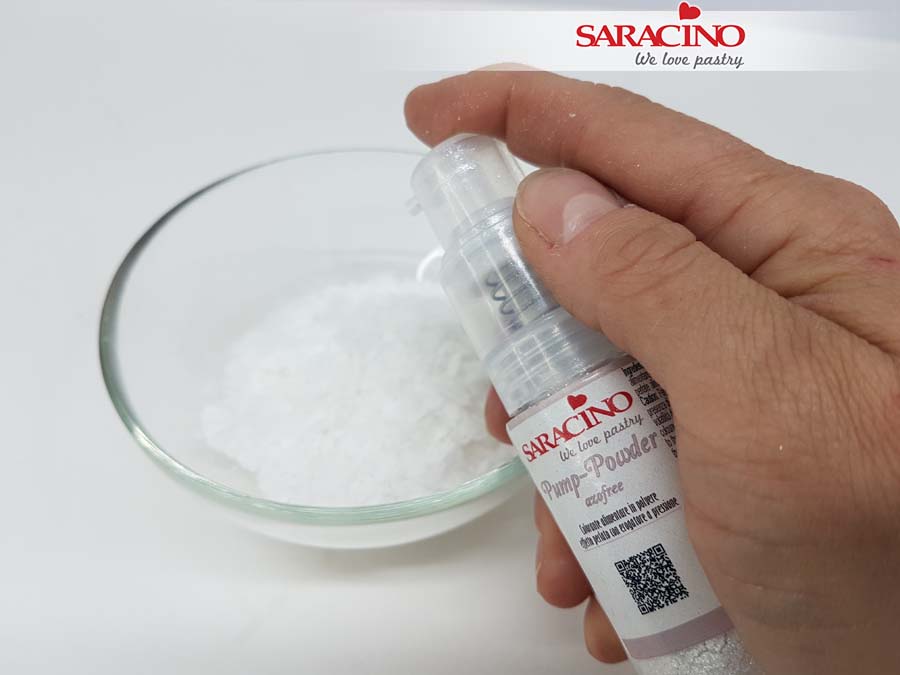
Step 50
Add Pump Powder silver glitter to give a sparkling effect.
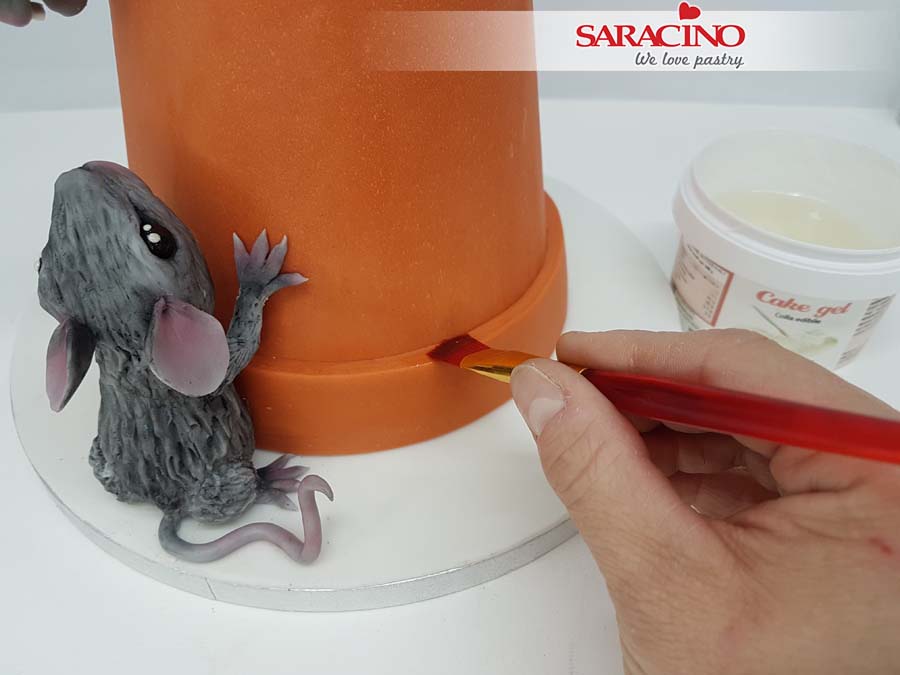
Step 51
Add a thin layer of cake gel to the top of the flower pot, the top of the rim and the cake drum.

Step 52
For the snow effect sprinkle the chopped wafer paper over the parts that are covered with cake gel.

Step 53
To highlight the hole mix brown powder colour with a small amount of clear alcohol. Make sure your brush semi dry and paint the shadow and shading.
TIP: Are the dust highlights too harsh or too clear? Gently wipe with a damp tissue over the part that you want to blend.

Step 54
Finally, finish your drum with a ribbon of your choice.



